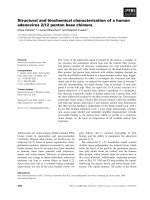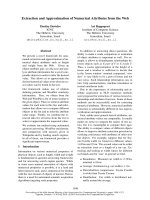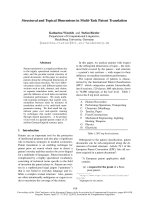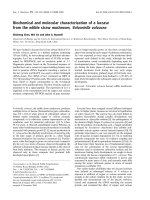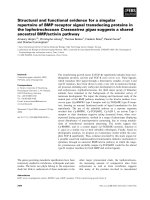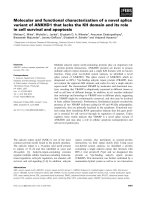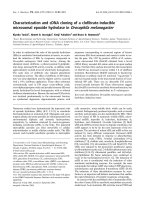Báo cáo khoa học: "LEXICAL AND SYNTACTIC RULES IN A TREE ADJOINING GRAMMAR" pdf
Bạn đang xem bản rút gọn của tài liệu. Xem và tải ngay bản đầy đủ của tài liệu tại đây (319.35 KB, 7 trang )
LEXICAL AND SYNTACTIC RULES IN A
TREE ADJOINING GRAMMAR
Anne Abeill6*
LADL and UFRL
University of Paris 7-Jussieu
ABSTRACT
according to this definition 2. Each elementary
tree is constrained to have at least one terminal
at its frontier which serves as 'head' (or 'anchor').
Sentences of a Tag language are derived from the
composition of an S-rooted initial tree with other
elementary trees by two operations: substitution
(the same operation used by context free
grammars) or adjunction, which is more
powerful.
Taking examples from English and French idioms, this
paper shows that not only constituent structures
rules but
also most syntactic rules (such as topicalization, wh-question,
pronominalization ) are subject to lexical constraints (on
top of syntactic, and possibly semantic, ones). We show that
such puzzling phenomena are naturally handled in a
'lexJcalized' formalism such as Tree Adjoining Grammar. The
extended domain of locality of TAGs also allows one to
'lexicalize' syntactic rules while defining them at the level of
constituent structures.
1 INTRODUCTION TO 'LEXICALIZED'
GRAMMARS
1.1 Lexicalizing Phrase Structure rules
In most current linguistic theories the
information put in the lexicon has been increased
in both amount and complexity. Viewing
constituent structures as projected from the
lexicon for example avoids the often noted
redundancy between Phrase Structure rules and
subcategorization frames. Lexical constraints on
the well-formedness of linguistic outputs has also
simplified the previous transformational
machinery.
Collapsing phrase-structure rules into the
lexicon is the overt purpose of 'lexicali7ed'
grammars as defmed by Schabes, Abeill6, Joshi
1988 : a 'lexicallzed' grammar consists of a fmite
set of elementary structures, each of which is
systematically associated with one (or more)
lexical item serving as 'head'. These structures are
combined with one another with one or more
combining operation(s). These structures specify
extended domains of locality (as compared to
CFGs) over which lexical constraints can be
stated. The 'grammar' consists of a lexicon where
each lexical item is associated with a finite
number of structures for which that item is the
'head'.
We here assume familiarity with Tree Adjoining
Grammars, which are naturally 'lexicalized'
* The author wants to thank Yves Schabes, Aravind Joshi,
Maurice Gro~, Sharon Cote and Tilman Becker for fruitful
discussions, and Robert Giannasi and Beatrice Santorini for
their
help.
Schabes, Abeill~, Jo~hl 1988 show that context
free grammars cannot in general be lexicalized
(using substitution only as the combining
operation). They also show that lexicalized
grammars are interesting from a computational
point of view since lexicalization simplifies
parsing techniques, because the parser uses only a
relevant subset of the entire grammar: in a first
stage, the parser selects a set of elementary
structures associated with the lexical items in the
input sentence, and in a second stage the
sentence is parsed with respect to this set. As
shown by Schabes, Joshi 1989, a parser's
performances are thus improved.
We show here that such 'lexicalization' should be
extended to other components of the grammar as
well, thus challenging the usual distinction
between 'lexical' and 'syntactic' rules. Further
parsing simplification is therefore expected.
1.2 'Lexicalizing' lexicai rules
As has often been noticed, rules (or transitivity
alternations) such as passive, particle hopping,
middle, dative-shift are subject to lexical
idiosyncrasies. There are of course syntactic and
semantic constraints governing such phenomena,
but lexical ones seem to be at stake to.
If one considers double objects constructions,
passivation of the second NP is regularly ruled
out on syntactic grounds. Passivation of the first
NP, on the other hand is subject to lexical
restrictions as the example of 'cost', opposed to
'envy' or 'spare', shows:
They envy John his new car.
John is envied his new car.
The mistake cost Mary a chance to win.
?* Mary was cost a chance to win.
The judge kindly spared John the ordeal.
John was kindly spared the ordeal.
One might argue that such differences may be
due to some semantic constraints, but even verbs
with similar meaning may exhibit striking
differences. For example, in French, 'regarder' in
292 2 Categorial grammars are also 'lexicalized'.
its figurative readin£ (to concern) and
'concerner', which is a true synonym in this
context, behave differently:.
Cette affaire regarde Jean
* Jean est regard6 par cette affaire
Cette affaire concerne Jean
Jean est conceru~ par cette affaire (M. Gross
1975)
It also seems a lexical phenomenon that "change"
but not "transform" allows for ergative alternation
in English'
The witch changed/transformed John into a wolf
John changed into a wolf
* John transformed into a wolf (G. Lakoff 1970)
To take another example, dative shift (or there-
insertion) is often thought of as applying to a
semantically restricted set of verbs (eg verbs of
communication or of change of possession, for
dative), but this does not predict the difference
between 'tell' that allows for it, and 'announce' or
'explain' which do not3:
John told his ideas to Mary
John told Mary his ideas
John explained his ideas to Mary
* John explained Mary his ideas
Lexicalist frameworks such as GPSG, which
handles such phenomena by metarules (defined
on 'lexical' PS rules), or LFG, which defmes them
at the f-structure level (ie between 'lexical forms')
could capture such restrictions. D. Flickin£er
1987 handles them explicitly with a hierarchical
lexicon in HPSG, considering such rules to hold
between two word classes (verbs here) and to
apply by default unless they are explicitly blocked
in the lexicon.
But all these representations rely on a clear-cut
distinction between lexical and syntactic rules and
it is not clear how they could be extended to the
latter.
2
LEXICAL CONSTRAINTS
ON SYNTACTIC
RULES
The distinction between 'syntactic' rules 4 that do
not usually change argument structure nor
3 To dismiss 'announce' or 'explain' on the mere basis of
their latin origin would not do, since 'offer', which comes
from latin as well, does exhibit dative shift.
4 Wc use the term 'rule' for conveniency. It does not matter
for our pu~, whether these phenomena are captured by
meaning of the sentence and are supposed to
apply regularly on syntactic structures, and
'lexical' rules that alter argument structure, may
change the meaning of the predicate and may
exhibit some lexical idiosyncrasies, usually
overlooks the fact that both are subject to lexical
constraints.
There has often been discussions about whether
certain rules, (eg passive or extraposition) should
be considered of one kind or the other. But it has
seldom been realized, to the best of our
knowledge, how often 'syntactic' rules are
prevented to apply on what seems purely lexical
grounds5.
Our discussion crucially relies on idiomatic or
semi-idiomatic constructions. We believe that a
sizable grammar of natural language, as well as
any realistic natural language application, cannot
ignore them, since their frequency is quite high in
real texts (M. Gross 1989). We first present
examples of such lexical constraints on
topicalization, pronomi~aliTation and wh-
question for both English and French idioms. We
then show that similar constraints can be found in
non idiomatic sentences.
2.1 Flexibility of idiomatic constructions
Idioms are usually divided into two sets (eg J.
Bresnan 1982, T. Wasow et al. 1982): 'fLxed' ones
(not subject to any syntactic rule) and flexible
ones (presumably subject to all). However, there
is quite a continuum between both.
Let us take two French idioms usually considered
as "fixed': 'casser la croflte' (to have a bite) and
'demander ia lune' (to ask for the impossible). It
is true that passivation or wh-question do not
apply to either. But pronominalization for the
former, cleft-extraction (c'est que) for the latter
do6:
Paul a casse la crotite (Paul had a bite)
# Quelle crofite casse-t-il ?
# C'est une petite cro0te qu'il a cassee.
derivation rules as such or by constraints on the well-
formedness of ou~ut structures.
5 An interesting exception being Kaplan and Zaenen 1989's
proposal that wh-movement and topicalization be
constrained at the f-structure level, ie by LFG's 'lexical
forms'.
6 # marks that the sentence is not possible with the desired
idiomatic interpretation. There may be some variations
among speakers about acceptability judgements on such
sentences (and on some of the following ones). Such
variability is indeed a property of lexical phenomena.
293
? Paul est en train de casser une petite cro~te et
j'en casserais bien une anssi. (Paul is having a
little bite, I wouldn't mind having one too)
Jeanne demande la lune
#
Ouelle lune demande-t-elle ?
C'est la lune qu'clle demande !
# Jeanne demande la lune et Paule la demande
aussi.
(Jeanne is askin~
for the moon and i'm
asking for it too)
These idioms are thus not completely fixed (as
opposed to idioms such as 'casser sa pipe' or 'kick
the bucket'), and some grammatical function
must be assigned to their frozen NPs. But the
differences among them are somewhat
unexpected: 'casser la cro~te' (where the noun
can be modified and take several determiners)
does not allow for more rules than 'demander la
lune' (where the frozen NP is completely fixed).
If one now takes an idiom usually considered as
flexible, 'briser la glace' (to break the ice), which
does passivize, we notice the same distribution as
with 'casser la crof, e':
Paul a bris6 la glace
# Ouelle glace a-t-il bris6e ?
# C'est la glace qu'il brise
77 Jean a bris6 la glace hier et c'est ~ moi de la
briser aujourd'hul. (Paul broke the ice yesterday
and I have to break it today)
Passive is allowed but not wh-question, nor
cleft extraction. It is difficult to dismiss such
phenomena as rare exceptions. Looking at
numerous idioms shows that one combination of
such rules is not more frequent than the other. It
is also difficult to fred a clear semantic principle
at work here.
Similar restrictions seem to be at work in
English. If one takes some English idioms usually
considered as 'flexible' (or even not idiomatic at
all): NP0 give hell/the boot to NP1. The main
verb 'give' seems to behave syntactically and
semantically as in non idiomatic constructions:
Dative shift applies and we have the regular
semantic alternation : NP1 get hell/the boot
(from NP0), with identical meaning. But it is not
the case that all expecte rules apply: passive is
blocked, pronominalization on the object too:
# Hell was given to Mary (by John)
# The boot was given to Mary (by
John)
# Alice gave hell to Paul yesterday and she is
giving it to Oscar now.
# Oscar gave the boot to Mary, and he will give it
to Bob too.
294
Syntactic rules may also apply differently to
distinct 'flexible' idioms. It is easy to lind idioms
which do passivize but don't allow for
pronominaliTation or topicaliTation in the same
way:
They hit the bull's eye.
The bull's eye, they hit.
? John hit the bull's eye and Paul hit it too.
They buried the hatchet.
77 The hatchet, they buried.
# John buried the hatchet and Paul buried it/one
too.
For relativation also, there might be similar
differences:
The strings that Chris pulled helped hime get the
job (Wasow et al. 1982)
# The bull's eye that John hit helped him get the
job.
# The hatchet that he buried helped him get the
job.
Distinguishing between fixed and flexible idioms
is thus not sufficient. Because different rules
apply to them differently, without a clear
hierarchy (contrary to Fraser 1970), one should
distinguish as many different types of flexibility as
there are possible combinations of such rules.
Similarly, if one wants to follow T. Wasow et al.
1982 's suggestion that some kind of
compositional semantics should be held
responsible for the syntactic flexibility of idioms,
as many degrees of compositionality should be
defined as there are combinations of syntactic
properties. Direct encoding of the latter is thus
preferable, and such a semantic 'detour' does not
seem to help.
This does not mean that no regularities could
be found for idioms' syntax but that they have to
be investigated at a more lexical level.
2.2 Some lexical constraints on non Idiomatic
constructions
Going back to non idiomatic constructions, it
seems that their syntactic properties may be
subject to similar lexical idiosyncrasies.
If one considers double objects constructions, It
seems a lexical phenomenon that wh-question on
the second N-P is allowed with 'give' or 'spare',
and not with 'envy' or 'cost', and that
topicalization is allowed with 'spare' only:
They envy John his new car
* What/* Which car do they envy John 7
* This brand new car, everyone envies John
The mistake cost Mary a chance to win
* What/ *Which chance did the mistake cost
Mary
?
* This unique chance,
the
mistake cost Mary
The judge' spared John the ordeal
What / Which ordeal did the judge spare John ?
This ordeal, the judge kindly spared John
If one now considers the first NP, topicMi-ation
appfies differently to:
* Mary, the mistake cost a chance to win
.9 John, you have always envied his extraordinary
luck
John, the judge kindly spared the ordeal
In French, as noted by M. Gross 1969, properties
usually thought of as applying to aLl 'direct
objects'(passivation, Que-question and Le-
cliticizatlon) may apply in fact unpredictingiy.
Although the objects of a verb like 'almer' (love)
take objects undergoing the three of them, the
object of 'valoir'(be worth) only allows for Que-
question and
Lc-¢llti¢i|TagiOiX, that of 'co~]tter'
(cost) only for Que-quesfion and that of 'passer'
(spend (time)) only allows for Le-cliticization:
Each elementary tree in a Tag is lexicalized in
the sense that it is headed by (at least) one lexical
item. The category of a word in the lexicon is the
name of the tree it selects. We only consider here
sentential trees for the sake of simpficity.
What lexical heads select is in fact a set of
such elementary trees called a "Tree Family ~
(Abeill~ 1988,
Abeill~
et al.
1990), each
tree
correspondln~
to
a certain
constituent sructure
(initial trees for wh-questions, auxiliary trees for
relative clauses ). This is the level at which
syntactic generMiTJtions can be stated, since each
elementary tree may bear specific constraints
independantly of any iexical items B. A Tree
Family consists in fact of all the constituent
structures trees which are possibly allowed for a
given predicate 9.
Examples of trees in the n0Vnl Family (verbs
taking
two NP
arguments) are the followlngl0:
II
S
a!
S
sP~ vl,
A NPo~ VP
VO NPI~
J
v9
Ce livre vaut cents francs.
(This book is worth 100 francs)
Ce livre les vaut.
Que vaut ce fivre
?
Ce
Hvre coQte cent
francs.
(This book costs I00 francs)
* Ce livre les co0te.
Que coOte ce liwe ?
11 a pass6 la nuit A travailler. (He spent the night
working)
II l'a pass6e t travailler.
*Qu'
a-t-il pass6 A travailler .97
These differences are all the more surpri~in£
that 'cofiter' and 'valoir' are otherwise very dose
verbs (same subcategorization frames, ~me
selectional restrictions).
Looking for some generalization principles with
which to predict such restrictions should be
pursued, but it seems that they will be of a lexlcal
kind.
3 LEXICALIZED RULES IN A TREE
ADJOINING GRAMMAR
3.1 Tree Families
7 ? Quelle nuit a-t-ii pasrde i travailler ? would be better.
295
S al s t~
A
NP,~t .,~tJ S
NP0~
VP
P NI~
I
8 Further subdividing these Tree Families, similarly to M.
Gross 1975's verb tables for French, and to D. Flickinger
1987's wcqrd classes for English, will help reduce the number
of features, and thus the amount of seemingly idiot~cratic
information, associated with each verb. However, as noted by
both authors, lexical idioayncrasies will never be eliminated
altogether.
9 Tree Family names (nOV, nOVnl ) are somewhat similar
to 'lexical forms' in LFG in the sense that they capture both
the predicate argument structure and the associated
grammatical functions (which we note by indices: 0 for
subject, l for first object ). Notice that the Tree Family name
does not change when lexical rules apply.
10~marks a substitution node,0marks the head. We use here
standard TAG trees for commodity of extx~tion, although
recent independent linguistic work suggests to slightly
modify
them, challenging for example the distinction between VP
and V levels (see Abeill~, in preparation).
Each tree is identified by a Tree family name
associated to a feature bundle correspondin~ to
the rules it involves. For example, a2, a3 and a4
are respectively marked11:
al (nOVnl) a2 (nOVnl)
passive f- passive = +
Wh-0 Wh-1 -
Wh-1 Wh-0 ffi
-
erg
=-
a3 (n0Vnl) a4 (n0Vnl)
passive=- passive ffi +
Wh-l=- Wh-1 = +
erg= + Wh-O = -
A given tree can belong to several
tree
families at the same time, which helps factorizing
the grammar in a parsing perspective. For
example, a3 can also be considered as belon~n~
to the nOV Family (for verbs with one NI'
argument) with a different feature bundle :
passive =-; Wh-0 = The lexical items headin~ the
tree constrain~ its interpretation, eg 'sleep' will
interpret a3 as nOV, while 'bake' or 'walk'
interpret it as n0Vnl.
Lexical constraints on syntactic and lexical
rules are handled by having the head select its
own subset of trees in its tree family.
For example, 'resemble' selects only active
trees; 'rumored' only passive ones, and 'love'
select both12:.
[love],V : n0Vnl [erg=-]
[resemble],V: n0Vnl [passive =-; erg=-]
[rumored],V: n0Vnl [part, lye = + ]
[donate],V; to,P : n0VPnl [dative =-;erg=-]
[give],V;to,P: n0VPnl [erg=-]
[spare],V:n0Vnln2
These features work as follows: when nothing
is said about a feature, it means that the predicate
selects trees with the feature being plus of
minus;
11 One might explicitly define materules, or links between
such trees: a passive rule for example, changes the feature
passive of the tree and intervert the features bearing on NO
and N1. Work is being curretly done along this line with T.
Becket, Y. Schabes and K. Vijay Shanker.
12 We note with square [I the set of inflected forms of a
lexical item. For example, [10ve] = give, g~.s, gave, giving.
given. We use a restriction principle to rule out erg= +
whenever passive = + (or dativ~ = +), and vice vemh to
the
ergative feature does not have to appear in the lexicon for
'rumored'.
when a feature is marked plus, it means that only
trees with this feature plus are selected (ie that
the corresponding rule is 'forced' to apply).
Such 'lexicallzation' of syntactic rules applies
similarly in idiomatic and non idiomatic
constructions.
3.2 Idioms in a Lexlcalized Tree Adjoining
Grammar
Tags seem a natural framework to represent
structures which at the same time are
semantically non compositional and should be
assigned regular syntactic structures (Abeill6 and
Schabes 1989, 1990). Idioms are thus made fall
into the same grammar as non idiomatic
coustructious. The only specificity of idioms is
that they are selected by a multicomponent head
(called 'anchor') and may select elementary trees
which are more extended than non idiomatic
constructions. Here are some examples of
elementary trees for 'kick the bucket', 'bury the
hatchet' and 'take NI' into account':
S i~
S ~t.
A A
NPo,L vr ~Po~ vp
V e Np I x
A
I I I I
the bucket tlx ~chet
A
NP0~ vr
0V NPx~. PP2 s't
I A
I I
into tN 2N A
I
Kcotm¢
The lexical anchors are respectively 'kick', "the'
and "bucket' for (1, 'bury', 'the' and 'hatchet' for
¢2, and 'take', 'into' and 'account' for ,t3. The
idiomatic interpretation of sentences such as
'John kicked the bucket', as opposed to their
296
literal readln~ is strail~forwardly based on their
distinct derivation trees'-':
toni[kick.
;]
o.N'Pn[John]
(1)
ctNPdntbucket]
(2.2)
c~tdnl[klck .the.bucket]
:
',
! !
¢zD[the] (1) o.NPa[John] (1)
literal derivation idiomatic derivation
Idiomatic and non idiomatic elementary trees are
gathered into tree families according to the
same principles. Here are some examples of the
trees belonging to the Family of idioms with a
frozen object (nOVDN1):
S ~
S
a 3
NPoi VP .%1*, *,
S
VO NP, N'Po,va VP
• ¢ ~ V¢ NIP:
//~ .~,f"x.,
vp .,,,,.o /,\
o
o
VO (Pp~
vo sP~.,
(~:0 / \
~1 ,v. V ,,
counterpart, although it allows for passive : "Par
quelle mouche a-t-il
6t6
piqu~ ?" (M. Gross
19s9).
[prendre],V;ie,D;temps,N: DN0Vnllpassive= +]
[piquer],V;mouche,N : NOVnl [Wh.N0 =+ ]
Notice that the tree familiy name tells not only
about the argument structure but also about the
head being multicomponent or not (all head
elements are noted with capital letter). Usually,
no part of a multicomponent head can be
omitted, and trees that are possible for this
argument structure but in which all head
elements could not be inserted will be ruled out.
For example, what-questions (noted Wh-i) are
generally disallowed with frozen nominals (and
thus not noted for each iexical entry), whereas
questions with wh-determiners (noted Wh-Ni)
are not:
John took a trip to Spain
# What did John take ?
? Which trip to Spain did John take ? (AbeRl6 et
at. 1990)
In fact, as has been noted by M. Gross 1989
for French, Wh-Ni questions seem to be ruled out
when the determiner of the argument is
completely fixed, as the following contrasts show:.
John spilled the/those beans
John buried the/#thi~/#a hatchet
Which bean(s) did John spill ?
# Which hatchet did John bury ?
Similarly, idioms bear syntactic features
constrainln£ the elementary trees of the Tree
Family they select. In the n0VDN1 Tree Family,
for e~mmple, 'kick the bucket' selects only al, and
the trees corresponding to wh-movement
on NO; 'bury the hatchet' selects
also the trees for passive (and possibly
topic~liT.'ation on N1).
[bury],V;the,D;hatchet,N: n0VDN1 [Wh-N1 •-]
[kick],V;the,D;bucket,N: n0VDN1 [passive=-;
Wh-N1 =-; Top-N1=-]
This generalization which can be captured since
the Tree family names will be different (with D
for frozen determiners, and d for not frozen
ones):
[spill],V; [beun],N: n0VdN1
[bury],V; the,D; hatchet,N: n0VDN1
The trees for the Wh-N questions will thus belong
only to the corresponding 'd' Families, and not to
the 'D' ones.
CONCLUSION
There are some idioms which exist only in the
passive form, or in the question form, and the
correspond;no trees are directly selected. In
French, "~tre pris par le temps" (to be very busy)
lacks its active counterpart (* Le temps prend
Jean), and "Quelle mouche a piqe6 NP ?" (What's
eating NP ?) lacks its non interrogative
13 "l'he derived trees are the same (modulo the syntactic
features explained above).
297
It has been shown that taklno, idiomatic or semi-
idiomatic constructions into account in a French
or Enali~ grammar forces one to define some
lexical constraints on syntactic rules such as wh-
question, pronominaliTation and topicalization.
Such a lexical treatment has been exemplified
using Lexicalized Tree Adjoining grammars. An
interestlno point about TAGs is that, due to their
extended domain of locality, they enable one to
consider as 'lexicar syntactic rules bearing on
constituent structures, and not only rules
changing the syntactic category of a predicate (as
D. Dowry 1978) or rules chan#,~ the argument
structure of a predicate (as in T. Wasow 1977 or
D. Flickinger 1987).
REFERENCES
AbeilM A., 1988. "Parsing French with Tree
Adjoinlnz grammar', Coling'88, Budapest.
AbeiU6 A., Schabes Y., 1989. "Parsing idioms
with Lexicalized Tags', Proceedings of the
European ACL meeting, Manchester.
AbeilM A., Schabes Y., 1990. "Non compositional
discontinuous constituents in Lexicali7¢d TAG',
Proceedings of the international workshop on
discontinuous constituency, Tilburg.
AbeiU6 A., K. Bishop, S. Cote, Y. Schabes, 1990.
A lexicalized Tree Adjoining Grammar for
English, Technical Report, CIS Dpt, University of
Pennsylvania, Philadelphia.
Bresnan J., 1982. "Passive in lexical theory ~, in
Bresnan (ed), The Mental Representation of
Grammatical Relations, MIT Press.
Dowty D., 1978. "Governed tra-~formations as
lexical rules in a Montague grammar', Linguistic
Inquiry, 9:3.
Flickinger, D. 1987. Lexical rules in the
hierarchical lexicon, PhD Dissertation, Stanford
University.
Gross M., 1969. "Remarques sur la notion d'objet
direct en Franqais", Langue frw~faise, n°3, Pads.
Gross M., 1975. Mdthodes en syntaxe,
Hermann~
Paris.
Gross M., 1989. "Los expressions fig6es en
Franfais', Technical Report, LADL, University
Paris 7, Paris.
Kaplan R., Zaenen A., 1989. *Long distance
dependencies, Constituent structure and
Functional uncertainty", in Baltin & Kroch (eds),
Alternative Conceptions of Phrase Structures,
Chicago Press.
G. Lakoff, 1970. Irregularity in Syntax, Holt,
Rinehart and Winston, New York.
Schabes Y., AbeilM A., Joshit A., 1988. "Parsing
strategies with 'lexicaliTed' grammars",
Proceedings of COLING'88, Budapest.
Wasow T., 1977. "Transformations and the
lexicon", in P. Culicover et al. (eds), Formal
syntax, Academic press, New York.
Wasow T., Sag I., Nunberg G., 1982. "Idioms: an
interim report", Proceedings of the XIIIth
international Congress of Linguists, Tokyo.
298


